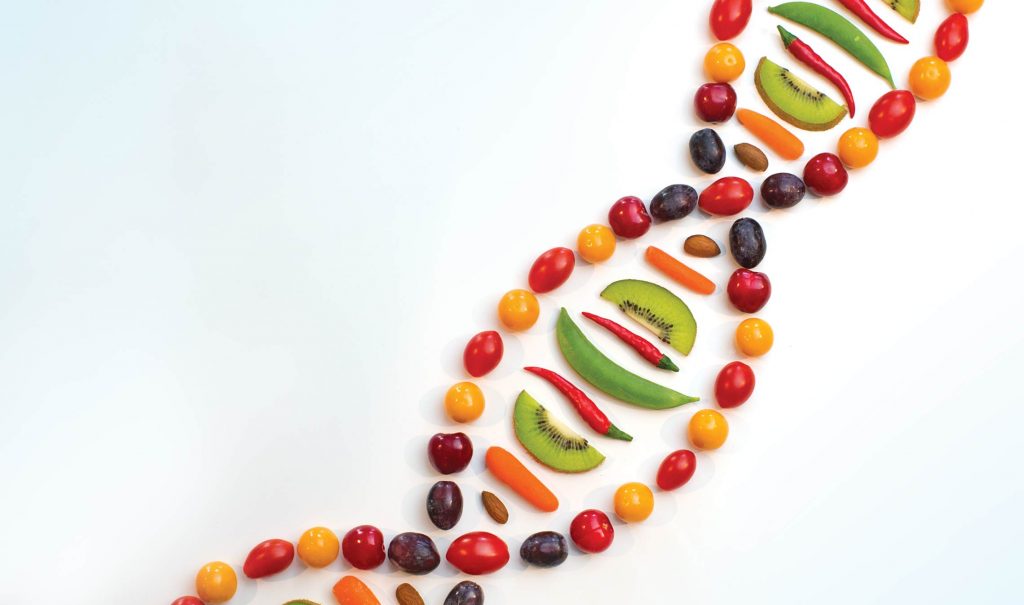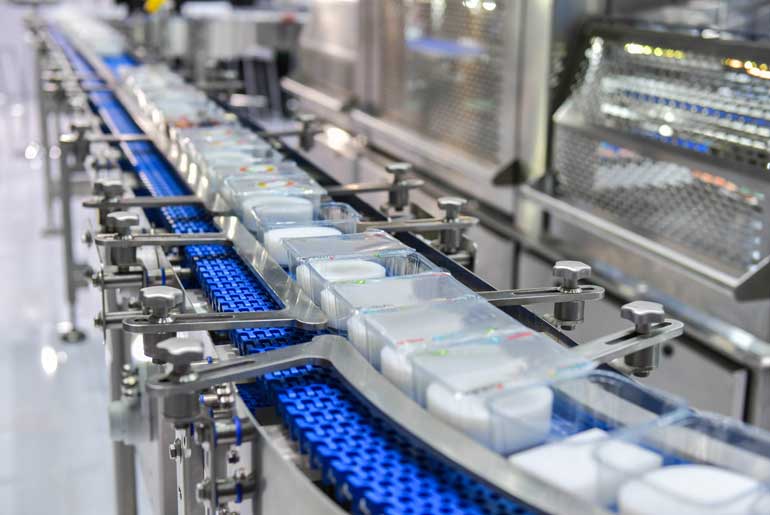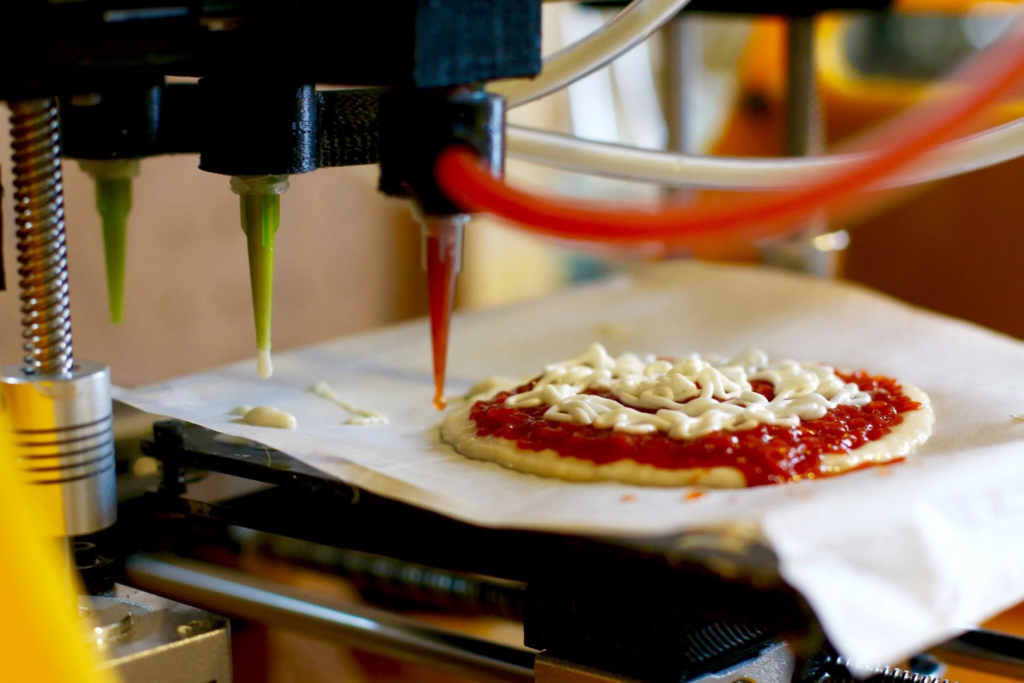5 Healthy Food & Beverage Trends to Foresee in 2024
The healthy foods industry is growing rapidly and is projected to reach a market value of approximately $1.4 trillion by 2027! Consumers are increasingly seeking products containing organic, low-carb, dairy- and gluten-free characteristics. Being health conscious is the new post-pandemic normal.
According to Archer-Daniels-Midland, approximately 31% of consumers buy more products tailored to their health, and 50% prefer food and beverage products that naturally contain beneficial ingredients.
Foods genetically designed for a specific individual’s physiology are gaining popularity. Additionally, massive companies like Nestle are creating allergy-free foods for infants. This detailed report explores all this and more food and beverage industry innovations and trends.
You can easily save this entire report as a PDF to read later and share with your team. Fill out the simple form below and get a copy sent directly to your mail.
1. Vegan probiotics

Vegan probiotics are supplements or foods and beverages containing beneficial bacteria derived from plant-based sources, avoiding animal-derived ingredients. These microorganisms, such as Lactobacillus and Bifidobacterium strains, are crucial for promoting a healthy balance in the digestive system.
As the demand for plant-based products grows, so does the market for vegan probiotics. The global demand for vegan probiotics is projected to reach a market size of approximately $10.69 million by 2028.
Vegan probiotics are available in various forms, including capsules, powders, and fermented plant-based foods like sauerkraut.
Latest innovations in vegan probiotics
Recently, many start-ups have been coming up in the domain of vegan probiotics, such as OptiBac Probiotics, Yofix Probiotics, Eguup, etc.
OptiBac Probiotics
OptiBac Probiotics is a supplement that contains a patented strain of bacteria called Lactobacillus rhamnosus GG. Yofix Probiotics launched a probiotic yogurt with Lactobacillus, Streptococcus, and Bifidobacterium families of bacteria. Eguup has developed vegan probiotic products.
The products are based on vegan probiotics and prebiotic formulas containing Bifidobacteria Lactobacillus and Streptococcus.
Danone
Danone, a world-known food company, has developed a probiotic fermented plant-based (hydrolyzed oats) composition comprising a vegetal base, heterofermentative bifidobacteria, lactic acid bacteria, as well as homofermentative lactic acid bacteria.
This carefully curated blend sets the foundation for the subsequent steps. Then, the mixture undergoes fermentation, a crucial phase in the process, leading to a fermented plant-based composition. The vegetal base consists of a minimum of 50% sugars with a degree of polymerization ranging from DP1 to DP2. This specific sugar composition contributes to the characteristics and qualities of the final product.
Mahakaushal University
The University of Mahakaushal has patented a plant-based probiotic drink formula consisting of a bacteria species from Lactobacillus acidophilus and Lactobacillus plantarum. All these innovations indicate a high growth in vegan probiotics in the upcoming years.
Growth and Collaborations among Vegan Probiotic Companies
Novozymes and Chr. Hansen formed Novonesis
Novozymes, the world’s largest microbial technologies and enzymes provider, has merged with Chr. Hansen, a bioscience supplier, and formed Novonesis. This Danish merger, reportedly the largest ever in the country, provides plant-based food and health bio solutions and household care across 30 industries.
Infinite Roots secured a substantial Series B funding.
The German biotech company Infinite Roots secured $58 million in an oversubscribed Series B funding round. This investment was Europe’s largest ever in mycelium. Infinite Roots uses patented fermentation technologies to develop innovative solutions.
The funding will support the company’s commercial growth, including expanding production capacities and launching worldwide.
Evogene Ltd. and Verb Biotics
Evogene Ltd. and Verb Biotics have entered into a collaboration agreement to advance life-science products. The former company is knowledgeable in bacterial-based product development utilizing its tech-engine MicroBoost AI. On the other hand, Verb Biotics has access to various microbial genome strains that support the production of microbial metabolites, which are vital for human health.
Partnering with Evogene equips Verb Biotics with a powerful edge to revolutionize microbiome-driven health solutions. By leveraging Evogene’s technology, we further streamline and de-risk our innovation pathway, prioritizing function-first approaches for optimal microbiome health.
– Noah Zimmerman, CTO at Verb Biotics
Recommended: Making Cheese from Microbes using Precision Fermentation!
2. Gene/DNA-based nutrition

The DNA-based diet market will reach $1.8 billion by 2030. This upward trend indicates a growing awareness and interest in personalized nutrition, driven by technological advancements and an increasing understanding of how diet affects health.
Owing to inactive lifestyles and unhealthy dietary practices, numerous urban dwellers face the threat of lifestyle-related disorders such as obesity. While personalized diet management considers factors like body type and activity levels, it often overlooks genetic predispositions to diseases and the ability to process various foods.
This process involves creating personalized diets for individuals by analyzing metabolism-related genes, nutrient absorption, and response to certain foods. This optimizes health by aligning nutrition with an individual’s genetic predispositions, potentially preventing or managing conditions influenced by genetic factors.
Innovation in DNA-based nutrition
Several companies like Vitl, Vieroots, and others work in this domain. To address this deficiency, emerging food and beverage startups provide gene-based nutrition plans, making it one of the notable industry trends.
Vieroots
An Indian startup, Vieroots, integrates genetic testing and metabolomic assessments to craft personalized nutrition plans. The company claims the utilization of nutrigenomics for research and development in areas such as nootropics, mental health, and gut health, extending its recommendations beyond food to include beneficial exercises.
Nestle
Nestle has developed an AI-based system that identifies individual nutritional needs, dietary rules, and potential inadequacies by comparing them with ADF diet nutrients. The invention provides consolidated dietary recommendations, nutritional solutions tailored to the ADF context, and optional lifestyle recommendations. Notably, it aids dietary decision-making and estimates prospective nutritional status through diet simulation. Furthermore, it raises awareness of nutritional risks in ADF and guides users to fulfill nutrient requirements with foods, beverages, and dietary supplements specific to their ADF regimen.
The company claims that the system helps in dietary decision-making, establishing personalized nutritional risk mitigation plans, and prompting users to meet nutrient requirements in their ADF lifestyle.
DSM
DSM, a Netherland-based health & nutrition company, has developed a computer-based method to formulate a vitamin and mineral premix tailored for a non-animal protein alternative to meat or fish, particularly within a chosen product market.
Additionally, the invention encompasses the development process of such alternatives, the alternatives themselves, and the utilization of the designed premix, as guided by the computer-based method. This helps adjust the vitamin and mineral levels in the alternative, aligning them with those present in the meat being substituted.
Growth and Collaborations among Innovators in DNA Nutrition
BASF and Segterra/Xerion Collaboration
The German chemical company BASF partnered with Segterra and Xerion Limited to deliver personalized nutrition solutions. These collaborations aim to enhance individual well-being based on genetic insights.
This collaboration has yielded several products. The most notable ones are:
- PUFAcoat™ Omega-3 Index Test Kits: These kits utilize Xerion’s proprietary dried blood spot technology. This helps track cardiovascular health and make informed decisions on omega-3 intake. These kits are exclusively distributed by Newtrition®, BASF’s human nutrition brand.
- InsideTracker: Developed by Segterra, InsideTracker is an online platform that offers personalized health analytics, nutrition, and dietary supplementation recommendations to the US market.
Recommended: 5 Innovation Trends Shaping the Food and Beverage Industry
3. Non-thermal food processing

Non-thermal food processing refers to using methods and technologies for preserving and treating food without relying on traditional heat-based techniques like cooking or pasteurization. This approach aims to retain the nutritional quality, flavors, and overall characteristics of the food while extending its shelf life and ensuring safety.
The Non-Thermal food processing market is projected to reach $4.6 billion by 2027. The demand for foods processed as such is estimated to increase with the rising need for prepared foods, such as frozen, ready-to-eat, and processed foods.
These processing methods include various technologies such as high-pressure processing (HPP), pulsed electric field (PEF) processing, ultrasound, irradiation, and cold plasma treatment. These techniques can deactivate food microorganisms, enzymes, and pathogens without subjecting them to the high temperatures associated with conventional thermal methods.
Why is Non-Thermal Food Processing a Trend?
Non-thermal food processing has gained attention for its potential to reduce energy consumption, minimize nutrient loss, and enhance the overall quality of processed foods.
Furthermore, a survey was conducted by Western Kentucky University, comprising 223 respondents from various regions of the United States. In this, 71% mentioned that the main driver for choosing non-thermal food processing was better nutrient and sensory properties.
Also, 41% of respondents believed high investment was the major limitation in implementing non-thermal food processing technologies.
Innovation in non-thermal food processing
Brawijaya University
Brawijaya University developed a non-thermal pasteurization machine that uses High-intensity pulsed Electric Fields (PEF) to serve as a non-thermal food processing technique involving powerful electric shocks.
Specifically used for liquid materials, fruits, and vegetables rich in heat-sensitive vitamins, High-PEF has a brief treatment duration ranging from one microsecond to one millisecond, utilizing short but intense voltage pulses. The Pulsed Electric Field (PEF) process involves applying short pulses at high voltage (20-80 kV/cm) to food between two electrodes. This facilitates an effective pasteurization process for fruits and vegetables, ensuring optimal results.
Mirae Life Resources
Mirae Life Resources, a South Korea-based life science company, developed a food ultra-high pressure sterilization treatment method that involves cooling the food and subjecting the cooled animal food to ultra-high pressure processing at 400 MPa to 600 MPa.
Notably, the ultra-high pressure treatment employs adiabatic compression. This method offers a means of sterilizing food without heating, thereby preserving the original taste and aroma of the raw ingredients. The company claims that the method eliminates microorganisms and enhances the chewing experience by augmenting binding forces (agglomeration) through alterations in the animal food’s protein function, thereby increasing its chewing appeal.
Download the entire PDF report on food and beverage trends for offline reading and sharing. Simply fill out the form below and get the report delivered to your inbox.
4. Allergy-free infant food

Allergy-free infant food refers to specially formulated products designed for infants at risk of or diagnosed with food allergies. These products are meticulously crafted to exclude common allergens such as cow’s milk, soy, wheat, eggs, peanuts, tree nuts, fish, and shellfish.
The goal is to provide a safe and nutritionally balanced alternative for infants with known allergies or a predisposition to allergic reactions. Allergy-free infant foods often come in various forms, including hypoallergenic formulas, pureed baby foods, or baby cereals, carefully crafted to meet the nutritional needs of infants while avoiding ingredients that may trigger allergic responses.
Why are Allergy-free infant foods trending?
Infant nutrition is a massive market worth $88 billion, projected to grow to $125.67 billion by 2028. The number of children experiencing food allergies has been growing about four times faster than the population for at least 20 years, which has led to an increased demand for allergy-free foods.
These products are typically developed under strict guidelines and may be recommended by healthcare professionals for infants with specific dietary requirements.
According to a study, childhood food allergies cost U.S. families $20.5B annually, averaging $4,184 per child per year. Further, 76% of pediatricians reported that new parents are not even aware of or have information about the infant’s allergies. As the population gains awareness of these issues and the prevalence of these allergies increases in the infant population, the innovations in this space are expected to increase exponentially.
Innovation in Allergy-free food for infants
Various Companies are working on developing allergy-free infant food products, including Nestle, Danone Nutricia, Parent’s Choice Infant Formula, and Milk Care Company Inc.
Milk Care Company Inc.
Milk Care Company Inc. has introduced an innovative infant formula combining human milk proteins with animal or plant protein options. Some formulations exclusively feature recombinant or extracted human milk proteins, addressing the dietary needs of newborns with cow’s milk protein allergy or dairy sensitivity.
This invention provides versatile formulas, including hydrolyzed or amino acid-based variants, offering a solution for infants dealing with milk protein allergy, allergic proctocolitis, or formula intolerance. Furthermore, the patent outlines methods for delivering nutrition to infants struggling with protein-based formula tolerance, presenting a comprehensive approach to early-life dietary challenges.
Designed to be free of non-human animal and vegetable proteins, the formula’s controlled composition, focusing on specific human milk proteins, ensures suitability for various nutritional needs.
Nestle
Nestle has developed nutritional formulations designed for infants and young children, incorporating human milk oligosaccharides (HMOs), such as 2′-fucosyllactose (2FL) and lacto-N-neotetraose (LNnT), to influence the maturation of the gut microbiome. This formulation is a hydrolyzed formula (eHFs) or an amino acid-based infant formula (AAFs). It is suitable for infants dealing with cow’s milk protein allergy.
LG Household & Health Care
LG Household & Health Care developed a liquid formula milk composition that enhances the nutrients required for infants and young children and has allergy-reduction effects. It has α-lactalbumin and αS1-casein in a weight ratio of 1:0.5 to 5 (α-lactalbumin:αS1-casein), and milk-derived milk powders, proteins, or mixtures thereof are used in an amount of 0.1 to 7% by weight relative to the total weight of the composition.
A liquid milk formula composition comprising 15 to 40% by weight of milk-derived milk based on the total weight of the composition. The company claims the composition has phase stability compared to conventional formula milk.
5. 3D-Printed Foods

3D food printing is an innovative culinary technology that creates edible items layer by layer using edible ingredients. It involves precisely depositing food materials, such as dough, chocolate, or purees, through a computer-controlled nozzle. The stringent quality assurance and exceptional nutritional control achieved by 3D printing are revolutionary.
This method enables the customization of food shapes, textures, and flavors with great precision, offering new possibilities in gastronomy and addressing dietary preferences.
Why is 3D-printed Food Trending?
Although a fairly smaller trend, the 3D food printing market is expected to reach $11.3 billion by 2030. The rising consumer demand for customized and personalized food products is boosting the demand for 3D printers.
Market research suggests that 3D printing of foods is not cost-effective. But it can potentially revolutionize the food industry through sustainable, personalized nutrition and culinary creativity.
Innovation trends among 3D-printed food and beverage companies
Natural Machines
Natural Machines is a Spanish company that developed the Foodini, a 3D food printer designed for professional and home kitchens. The Foodini can print various foods, including pasta, pizza, and chocolate. One only needs to load the printer with the ingredients needed for the recipe.
Additionally, one of the advantages of the Foodini is that it allows for precise control over the amount and placement of ingredients. The company has worked with some big names in the industry, such as Nestle, Pepsico, Whitsons Culinary Group, etc.
Nūfood
NuFood is a 3D food printing technology that uses a unique printing method to create customized and nutritious food items. This technology is based on a patent-pending process involving high-pressure extrusion to create intricate designs using various food materials.
One of the unique features of the NuFood system is the ability to print customized and nutritious food items. The software program allows users to adjust the amount of protein or fiber in the material. This makes the NuFood technology particularly useful for creating specialized diets or catering to individual dietary requirements.
Redefine Meat
Redefine Meat, an Israeli food startup, makes 3D-printed, plant-based beef substitutes. Their patented 3D-printed beef composition combines soy & pea protein, chickpeas, beetroot, nutritional yeasts, and coconut fat. It resembles flank steak, which is also known as bavette.
Their whole-cut meats appeal to many customers through the 150 restaurants they partner with in Israel. Their products require far less refrigeration and have a longer shelf life. These analogs have no cholesterol content, making them more accessible to health-conscious people.
Furthermore, the company claims its 3D-printed meat decreases environmental impact by 95% while being cheaper than traditional meats.
Recommended: Seven Trends Among 3D Printed Food and Beverage Startups Disrupting the F&B Industry
Conclusion
These were the 5 leading food and beverage industry trends to prepare for in 2024 and beyond. These trends indicate a growing awareness and demand for healthier food options.
But the F&B industry is transforming, and we are bound to see other trends continuing to grow, such as:
- Salt & sugar reduction
- Alternative proteins
- Vacuum frying
- Advanced cooking oil formulations
- Food adaptogens
- Cannabis-based ingredients.
Get complete details on all food and beverage industry trends along with the latest innovations and future outlooks. Talk to our industry expert today.

Authored By – Ambuj and Mukul, Intelligence
Edited By – Hemanth Shenoy, Marketing




